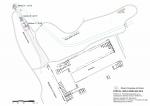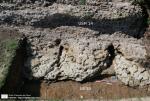Summary (English)
This was the second season of excavations on the north-south mole at Portus, part of the five-year project (2017-2021) “Ostie-Portus: Hub de l’empire romain” run by the École française de Rome. The mole, c. 300 m long on a north-south alignment, is situated on the western edge of the archaeological park.
The 2018 investigations were dedicated to the study of the zone where the north end of the Claudian mole joined its first extension dating to the Severan period, which was investigated last year (Fig. 1). Therefore, an excavation area of c. 200 m2 was opened just south of last year’s area. The new area was divided into four trenches: two situated at the foot of the mole on the east side; one on the top and one for the surface cleaning of other structures on the east front. The aim was to observe the construction technique of the Claudian mole in greater detail and to gain an understanding of how the Severan extension was attached to it.
As regards the structure, there was a general reorganisation of the mole during the Severan period. In addition to the extension of c. 50 m to the north (Fig. 2), identified in 2017, this season’s excavations have shown that the walls of the Claudian structure that are visible today correspond with a Severan reconstruction. The latter is easily identifiable by the systematic use of typical thin red bipedales. In the same way, late antique additions can be seen in the structural sequence, both in the upper part and against the east front of the Claudian mole, which thus results as incorporated into the subsequent phases (Fig. 3).
Therefore, the Severan constructions used two different techniques: pouring cement on top of the earlier structures of the Claudian mole and then using the classical technique, beyond the latter’s north end, of catenae, stipites, and destinae. The latter is typical of structures standing in water, and does not appear in any other part of the Claudian mole that developed in connection with the portico of the so-called Trajanic Warehouses, situated 200 m to the south. In particular, the structural analysis showed how the first few metres of the Severan extension were without timber framework. In fact, a “platform” formed of mixed materials bonded with a very strong pozzolana mortar, was poured directly against the north wall of the original mole, thus creating a solid element on which to attach, later, the timber framework for the new mole.
As regards the original mole of Claudian date, it is probable that it was built using the same technique as that used for the foundations of the so-called Trajanic Warehouses, involving the use of opus caementicium in formwork for the lower part and the use of opus reticulatum for the standing parts guaranteeing that the mole stood above the water.As shown by the 2017 excavations, the mole’s structures underwent continuous transformations until the late antique period. If, on the one hand the late antique interventions substantially limit the possibility of finding the Claudian structures, on the other they show the mole’s long period of use, and overall the long life of the port site. The material finds are particularly important for the definition of this picture, as they are for the most part late antique ceramics.
- Evelyne Bukowiecki - École française de Rome
- Mimmo Milena - Centre Camille Jullian
Director
- Catherine Virlouvet - École française de Rome
Team
- Charles-Edouard Sauvin – Parigi
- Francesco Perotta – Sapienza Università di Roma
- Frumenti Ilaria
- Rémi Fabro – ArkoD Humanités Digitales
- Marta Fedeli
- François Fouriaux - École française de Rome
Research Body
- École française de Rome






![Download [PDF]](/excavation/skins/fasti/images/results/download_sml.png)

